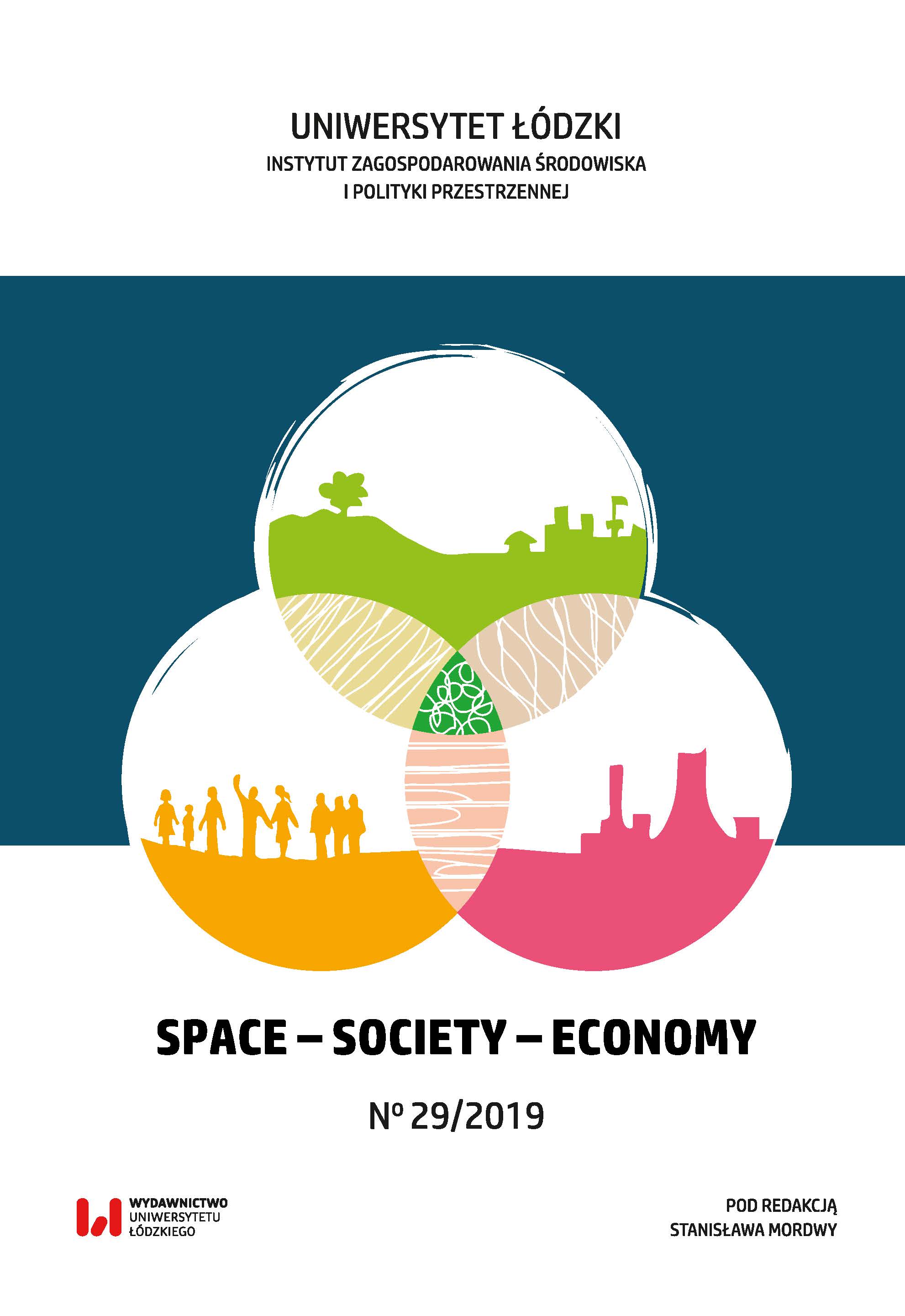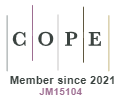Population ageing in polish cities and towns
DOI:
https://doi.org/10.18778/1733-3180.29.03Keywords:
ageing process, small towns, large towns, cities, demographic dependency ratio, index of demographic ageingAbstract
The inhabitants of cities and towns constitute more than 60% of the Polish population. The settlement system of Poland has a developed, multi-stage, hierarchical, urban structure, and the capital city has little advantage over other regional centres as compared with other European countries. Cities and towns, especially the latter, are evenly distributed over the area of the country. These features of the settlement system indicate its polycentrism. The demographic changes that have been observed in Poland for several decades, including population ageing, concern the inhabitants of cities, as well as large and small towns. However, both the level of population ageing in the urban units of varying sizes and the dynamics of this process are spatially diverse. The main purpose of this work is to determine the level and dynamics of population ageing in cities, large towns and small towns in Poland.
Downloads
References
Abramowska-Kmon A., 2011, O nowych miarach zaawansowania procesu starzenia się ludności, „Studia Demograficzne”, 1 (159): 3–33.
Google Scholar
Avramov D., Maskova M., 2003, Active ageing in Europe, „Population Studies”, 41 (1): 1–152, Council of Europe Publishing.
Google Scholar
d’Albis H., Collard F., 2013, Age groups and the measure of population aging, „Demographic Research”, 29: 617–640.
Google Scholar
DOI: https://doi.org/10.4054/DemRes.2013.29.23
Cieślak M., 2004, Pomiar procesu starzenia się ludności, „Studia Demograficzne”, 2 (146): 3–16.
Google Scholar
Clarke J.I., 1965, Population geography, Pergamon Press, Oxford.
Google Scholar
Długosz Z., 1997, Stan i dynamika starzenia się ludności Polski, „Czasopismo Geograficzne”, 68 (2): 227–232.
Google Scholar
Długosz Z., 1998, Próba określenia zmian starości demograficznej Polski w ujęciu przestrzennym, „Wiadomości Statystyczne”, 3: 15–25.
Google Scholar
Eurostat 2004, Ageing Population, [w:] Regions: Statistical Yearbook 2004, European Communities.
Google Scholar
Frątczak E., 2002, Proces starzenia się ludności Polski, „Studia Demograficzne”, 2 (142): 3–28.
Google Scholar
Gavrilova N.S., Gavrilov L.A., 2009, Rapidly Ageing Populations: Russia/Eastern Europe, [w:] Uhlenberg P. (red.), International Handbook of Population Aging, „International Handbooks of Population”, 1: 113–131, Springer.
Google Scholar
DOI: https://doi.org/10.1007/978-1-4020-8356-3_6
Grundy E., 1996, Population ageing in Europe, [w:] Coleman D. (red.), Europe’s population in the 1990s, Oxford University Press, New York.
Google Scholar
Haase A., Bernt M., Grossmann K., Mykhnenko V., Rink D., 2013, Varieties of shrinkage in European cities, „European Urban and Regional Studies”. DOI: http://dx.doi.org/10.1177/0969776413481985
Google Scholar
DOI: https://doi.org/10.1177/0969776413481985
Holzer J.Z., 2003, Demografia, Polskie Wydawnictwo Ekonomiczne, Warszawa.
Google Scholar
Janiszewska A, Dmochowska-Dudek K., 2017, Zróżnicowanie przestrzenne starzenia się w Łodzi, [w:] Pielesiak I. (red.), Starzenie się w środowisku miejskim. Ageing in Urban environment, „Space–Society–Economy”, 20: 9–22.
Google Scholar
DOI: https://doi.org/10.18778/1733-3180.20.02
Kaa D.J. van de, 2002, The Idea of a Second Demographic Transition in Industrialized Countries, Paper presented at the Sixth Welfare Policy Seminar of the National Institute of Population and Social Security, Tokyo, Japan, 29.01.2002, https://www.researchgate.net/publication/253714045_The_Idea_of_a_Second_Demographic_Trans-ition_in_Industrialized_Countries (dostęp: 10.10.2018).
Google Scholar
Kantor-Pietraga I., 2014, Systematyka procesu depopulacji miast na obszarze Polski od XIX do XXI wieku, Wydawnictwo Uniwersytetu Śląskiego, Katowice.
Google Scholar
Kijak R.J., Szarota Z., 2013, Starość. Między diagnozą a działaniem, Centrum Rozwoju Zasobów Ludzkich, Warszawa.
Google Scholar
King R., Warnes A.M., Williams A, 1998, International retirement migration in Europe, „International Journal of Population Geography”, 4 (2): 91–111.
Google Scholar
DOI: https://doi.org/10.1002/(SICI)1099-1220(199806)4:2<91::AID-IJPG97>3.0.CO;2-S
Kinsella K., Phillips D.R., 2005, Global Aging: The Challenge of Success, „Population Bulletin”, 60 (1): 2–44.
Google Scholar
Kondrat W., 1972, Zmiany w strukturze ludności według płci i wieku w latach 1950, 1960, 1970, „Studia i Prace Statystyczne”, 40: 24–34.
Google Scholar
Kot S.M., Kurkiewicz J., 2004, The new measures of the population ageing, „Studia Demograficzne”, 2 (146): 17–29.
Google Scholar
Kotowska I.E., 1999, Drugie przejście demograficzne i jego uwarunkowania, [w:] Kotowska I. (red.), Przemiany demograficzne w Polsce w latach 90. w świetle koncepcji drugiego przejścia demograficznego, „Monografie i Opracowania”, 461, Oficyna Wydawnicza Szkoły Głównej Handlowej, Warszawa.
Google Scholar
Kowaleski J., 2011, Przestrzenne zróżnicowanie starzenia się ludności Polski. Przyczyny, Etapy, Następstwa, Wydawnictwo Uniwersytetu Łódzkiego, Łódź.
Google Scholar
Kowaleski J.T., Szukalski P. (red.), 2004, Nasze starzejące się społeczeństwo. Nadzieje i zagrożenia, Wydawnictwo Uniwersytetu Łódzkiego, Łódź.
Google Scholar
Kowaleski J.T., Szukalski P. (red.), 2006, Starość i starzenie się jako doświadczenie jednostek i zbiorowości ludzkich, Uniwersytet Łódzki, Łódź.
Google Scholar
Kurek S., 1998, Zróżnicowanie przestrzenne procesu starzenia się ludności Europy w latach 1960–1996 w świetle wybranych mierników, „Czasopismo Geograficzne”, 69 (3–4): 261–274.
Google Scholar
Kurek S., 2001, Wybrane metody i kierunki badania starzenia się ludności w świetle literatury problemu, „Studia Demograficzne”, 1 (139): 97–113.
Google Scholar
Kurek S. 2003, The spatial distribution of population ageing in Poland in the years 1988– 2001, „Bulletin of Geography”, 2: 65–76, Nicolaus Copernicus University Press, Toruń.
Google Scholar
Kurek S., 2008, Typologia starzenia się ludności Polski w ujęciu przestrzennym, Wydawnictwo Naukowe Akademii Pedagogicznej, Kraków.
Google Scholar
Lesthaeghe R., 2010, The unfolding story of the second demographic transition, Research report 10–969, January 2010, Population Studies Center, University of Michigan, Institute for Social Research, https://www.psc.isr.umich.edu/pubs/abs/6089 (dostęp: 17.11.2018).
Google Scholar
Mazowiecki Ośrodek Badań Regionalnych, 2017, Portret Migranta. Migracje w m.st. Warszawie w latach 2005–2016, Warszawa, http://warszawa.stat.gov.pl/publikacje-i-foldery/ludnosc/portret-migranta-migracje-w-m-st-warszawie-w-latach-2005-2016,8,1.html (dostęp: 17.11.2018).
Google Scholar
Ministerstwo Infrastruktury i Rozwoju, 2015, Krajowa Polityka Miejska 2023, Warszawa, http://www.mir.gov.pl/miasta (dostęp: 17.11.2018).
Google Scholar
Podogrodzka M., 2014, Przestrzenne zróżnicowanie ludności według wieku w Polsce w 1991–2010, [w:] Rączaszek A., Koczur W. (red.), Polityka społeczna wobec przemian demograficznych, „Studia Ekonomiczne UE w Katowicach”, 167: 62–76.
Google Scholar
Podogrodzka M., 2016, Przestrzenna konwergencja indeksu starości w Polsce, „Acta Universitatis Lodziensis. Folia Oeconomica”, 4 (324): 51–65.
Google Scholar
DOI: https://doi.org/10.18778/0208-6018.324.04
Potrykowska A., 2003, Przestrzenne zróżnicowanie procesu starzenia się ludności i migracji osób w starszym wieku w Polsce, „Przegląd Geograficzny”, 1: 41–59.
Google Scholar
Preston S.H., Himes C., Eggers M., 1989, Demographic Conditions Responsible for Population Ageing, „Demography”, 26 (4): 691–704.
Google Scholar
DOI: https://doi.org/10.2307/2061266
Raport Espon 1.1.1, 2004, Potentials for polycentric development in Europe, https://www.espon.eu/programme/projects/espon-2006/thematic-projects/urban-areas-nodes-polycentric-development (dostęp: 17.11.2018).
Google Scholar
Rossa A. (red), 2012, Wprowadzenie do gerontometrii, Wydawnictwo Uniwersytetu Łódzkiego, Łódź.
Google Scholar
Rosset E., 1959, Proces starzenia się ludności. Studium demograficzne, Polskie Wydawnictwa Gospodarcze, Warszawa.
Google Scholar
Rosset E.,1967, Ludzie starzy. Studium demograficzne, Polskie Wydawnictwo Ekonomiczne, Warszawa.
Google Scholar
Rowland D.T., 1996, Population momentum as a measure of aging, „European Journal of Population”, 12: 41–61.
Google Scholar
DOI: https://doi.org/10.1007/BF01797165
Sanderson W., Scherbov S., 2005, Average remaining lifetimes can increase as human populations age, „Nature”, 435: 811–813.
Google Scholar
DOI: https://doi.org/10.1038/nature03593
Sanderson W., Scherbov S., 2007, A new perspective on population ageing, „Demographic Research”, 16 (2): 27–58.
Google Scholar
DOI: https://doi.org/10.4054/DemRes.2007.16.2
Szajewska N., 2013, Modele kurczących się miast – wnioski do badań, [w:] Zarządzanie rozwojem miast o zmniejszającej się liczbie mieszkańców (w kontekście perspektywy finansowej 2014–2020), Kancelaria Senatu, Warszawa: 160–175.
Google Scholar
Szarota Z., 2010, Starzenie się i starość w wymiarze instytucjonalnego wsparcia, Wydawnictwo Naukowe Uniwersytetu Pedagogicznego, Kraków.
Google Scholar
Wieniecki I.G., 1981, Starzenie się ludności i metody statystyczne jego pomiaru, [w:] Metody statystyczne w demografii, PWN, Warszawa: 76–90.
Google Scholar
Wolańska W., 2013, Przestrzenne zróżnicowanie starzenia się ludności Polski w latach 1995–2035, „Acta Universitatis Lodziensis. Folia Oeconomica”, 291: 249–263.
Google Scholar
Downloads
Published
How to Cite
Issue
Section
License

This work is licensed under a Creative Commons Attribution-NonCommercial-NoDerivatives 4.0 International License.









